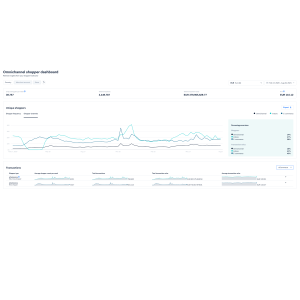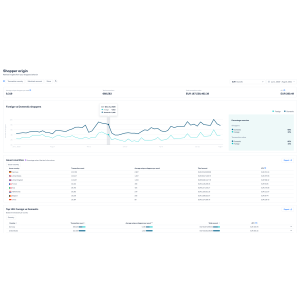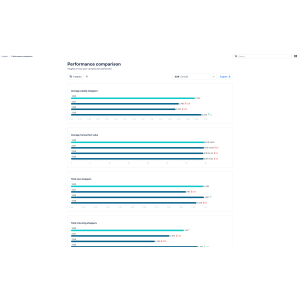Analyzing payment data can help identify shopper needs and trends. For example:
-
Shopper origin data show where your shoppers come from. If many are tourists, you could decide to add signage in other languages, offer currency conversion, and support the payment methods that those tourists are used to in their country/region.
-
If you investigate how many repeat shoppers you have and what they spend their money on, you can decide what items to keep in stock for your regular shoppers.
-
If you also have an ecommerce sales channel, you can answer questions like:
- How many in-store shoppers also bought online?
- How much do they spend in each channel?
- How many shoppers buy online and go to a store when they need to return goods?
Requirements
| Requirement | Description |
|---|---|
| Integration type | A Terminal API point-of-sale integration, and optionally an online payments integration as well. |
| Customer Area roles | To use Customer Area insights dashboards, make sure that you have the following role(s):
|
| Webhooks | To gather data yourself, especially in an omnichannel situation, enable standard webhooks. |
| Limitations | Starting January 12, 2026, the Omnichannel shoppers, Shopper origin and Performance comparison dashboards will be permanently shut down because we are evolving our data products at Adyen. If you have any questions, reach out to your Adyen contact. |
Ways to gain insights
There are two ways to gain actionable insights based on payment data:
-
Gather the data yourself.
You gather payment data that you receive from Adyen, add the data to your own database, analyze the information, and build your own dashboards. -
Use ready-made dashboards.
These dashboards provide high-level insights, directly in your Customer Area. The dashboards are based on aggregated data from payments made through your company and merchant accounts.We are evolving our data products at Adyen and are in the process of phasing out the Omnichannel shoppers, Shopper origin and Performance comparison dashboards.Starting January 12, 2026, these dashboards will be permanently shut down. If you have any questions, reach out to your Adyen contact.
Gathering data yourself
For each payment we return identifiers that let you recognize the card a shopper used, know where the shopper is from, and much more. By analyzing this data in combination with purchase data and data from other sales channels, you can gain all sorts of insights.
Below are card and shopper identifiers that you can use to gain insights into your shoppers:
- Card alias: a value that uniquely represents the shopper's card number (PAN), for example
A373176724022941. With this, you can recognize the card that a shopper is using and identify if they are returning customers. You cannot use the card alias for making payments. For NFC wallet transactions, there's no card alias because the PAN is not available. - Funding source: funding source of the card, for example debit, credit, or prepaid.
- Issuer country: the two-letter country code and the numeric country code of the country where the card was issued. This is a good indicator of the shopper's country/region of residence.
- Payment Account Reference (PAR): the PAR is an identifier behind the card or NFC wallet. It represents the payment account that the card and/or NFC wallet is linked to. It solves the issue with the PAN not being available for NFC wallet transactions. You can use the PAR to identify the shopper.
Card schemes are starting to adopt the PAR. Currently, we return it for Visa and MasterCard transactions, when available. The PAR can be returned for ecommerce transactions and for Terminal API payment and card acquisition requests.
You can gather this data in two ways:
- From standard webhooks
- From Terminal API payment responses
Using data from webhooks
To combine data from multiple sales channels, we recommend using standard webhooks for all channels. Standard webhooks are generated on our platform. They have the same format and are delivered in the same way across channels. This makes it easier to set up your integration for collecting data.
When setting up webhooks, you need to select the identifiers that you want to receive. See Receiving identifiers in webhooks for more information, and for an example standard webhook for a point-of-sale payment.
Using data from Terminal API responses
If you want to use Terminal API payment responses for gaining insights, you need to decide on the identifiers that you want to receive and, if necessary, enable receiving them.
Refer to Receiving identifiers in Terminal API responses for more information, and for an example of card and shopper identifiers in a point-of-sale payment response.
Customer Area insights dashboards
You can view the following insights dashboards in your Customer Area:
These dashboards are based on aggregated data from payments made through your company and merchant accounts.
The Performance comparison dashboard lets you:
Omnichannel shoppers dashboard
The Omnichannel shoppers dashboard shows the following data at the company or country/region level in a given period:
- Number of unique shoppers per channel: in-store, e-commerce, and omnichannel shoppers.
- Total number of transactions.
- Total and average transaction value.
- Number and value of transactions for returning shoppers and new shoppers, per channel.
Starting January 12, 2026, the Omnichannel shoppers dashboard will be permanently shut down. If you have any questions, reach out to your Adyen contact.
Click the image to enlarge it.
Transaction values are shown in EUR. When you select a different currency, we use the average currency conversion rate of the given period. As a result, converted transaction values are an approximation of the actual turnover in that currency.
- How many shoppers visit us on multiple sales channels, and how much do they spend in each channel?
- What is the average visit frequency for point-of-sale, e-commerce, and omnichannel shoppers?
Shopper origin dashboard
You can filter the Shopper origin dashboard on country/region, merchant account, or store. It shows where your shoppers came from in a given period.
Starting January 12, 2026, the Shopper origin dashboard will be permanently shut down. If you have any questions, reach out to your Adyen contact.
Click the image to enlarge it.
With this data you can answer questions like:- What payment methods should I support? If you receive many tourists in your store, you may want to support the payment methods that those tourists are used to in their country.
- For which locations and currencies should I enable Dynamic Currency Conversion?
- Which languages should I support? Think of in-store advertising and signage, and hiring store staff who speak specific languages.
Performance comparison dashboard
The Performance comparison dashboard lets you put the performance of your organization into perspective. You can:
- Compare a single company or merchant account over multiple periods.
- Compare multiple accounts over a single period.
Starting January 12, 2026, the Performance comparison dashboard will be permanently shut down. If you have any questions, reach out to your Adyen contact.
Click the image to enlarge it.
View the dashboards
To view the insights dashboards:
- Log in to your live Customer Area.
- Under Insights select the dashboard you want to view.
Compare one account over multiple periods
By comparing the performance of an account in two or more periods, you can see if, for example, your store is doing better now than it was doing before. This can help you set and evaluate targets for revenue, customer acquisition, and customer retention.
To make the comparison:
- In your live Customer Area, select the account that you want to make the comparison for.
- Go to Insights > Performance comparison and select Compare.
- In the menu, select the Dates comparison.
- Add two or more periods to compare. Select Add comparison for an additional period.
- Optionally filter the result.
Compare multiple accounts over a single period
By comparing the performance of multiple accounts in the same period, you can create benchmarks for your organization. Or you can gather input for periodical market reviews where you want to show the performance of different countries/regions or stores. The comparison can serve as a starting point to have a discussion about best practices and possible areas of improvement.
To make the comparison:
- In your live Customer Area, go to Insights > Performance comparison and select Compare.
- In the menu, select the Country, Merchant account, or Store comparison.
- Select the period that you want to compare performance for.
- Select two or more countries/regions, accounts, or stores to compare. The one that you select first, is used as the baseline. All percentages show the deviation in the performance compared to this baseline.


